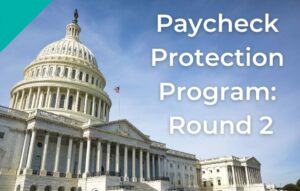What to Expect from the New Stimulus Bill for Your Business
Tax Extenders and PPP 2.0 for Businesses and Self-Employed
Less than two weeks after the Consolidated Appropriations Act was passed, Adams Brown hosted a webinar to help explain the major tax changes and updates for clients. Among other items, the Paycheck Protection Program was replenished, paid sick leave was extended, the employee retention tax credit was expanded, and several tax incentives were renewed at least into 2021.
PPP 1.0 and 2.0
 Most people are familiar with the Paycheck Protection Program (PPP), which was passed as part of the CARES Act originally and now refunded in the Consolidated Appropriations Act. In the months between PPP 1.0 – what we’re referring to as the original CARES Act PPP funding in both April and August 2020 – and PPP 2.0 – from the stimulus bill passed on December 27, 2020 – there were lots of questions about loan forgiveness and tax deductibility. Thankfully, those questions are mostly settled now as the Act clarified that forgiven PPP loans are non-taxable.
Most people are familiar with the Paycheck Protection Program (PPP), which was passed as part of the CARES Act originally and now refunded in the Consolidated Appropriations Act. In the months between PPP 1.0 – what we’re referring to as the original CARES Act PPP funding in both April and August 2020 – and PPP 2.0 – from the stimulus bill passed on December 27, 2020 – there were lots of questions about loan forgiveness and tax deductibility. Thankfully, those questions are mostly settled now as the Act clarified that forgiven PPP loans are non-taxable.
About $284 billion is available to first- and second-draw PPP borrowers through the Consolidated Appropriations Act. First-draw loans were made available on Monday, January 11, 2021, for borrowers who had not yet taken out PPP funds. Second-draw loans were available starting January 13, 2021, provided second-time borrowers met revised eligibility rules.
One of the changes for first-time borrowers is the expansion of eligible entities. For example, chambers of commerce or visitor centers are now eligible. Sole proprietor farmers also have expanded eligibility under the new rules. Farmers that didn’t qualify previously because they didn’t have any taxable income (due to depreciation or a loss, as an example) or employees are now eligible. If net income was negative, a farmer could instead use gross revenue from Schedule F.
First-draw loans are still subject to original requirements, such as less than 500 employees with a $10 million loan cap. Funds that are not forgiven are subject to a one percent interest rate over a repayment term of five years. First-time borrowers can use their 2020 average monthly payroll to calculate the maximum amount of funding, as opposed to their 2019 payroll for borrowers who applied earlier in 2020.
Second-draw PPP borrowers who did not use all of their original funds and have not yet applied for forgiveness can go back and obtain the rest of what they were eligible for before. Or, they can apply for second-draw loans under new guidelines, which are:
- 25 percent reduction in gross income in any quarter in 2020 compared to the same period in 2019
- 300 or fewer employees
- Lower maximum loan amount
- Certain businesses, like those in hospitality, can use 3.5 times monthly average payroll instead of 2.5 times
Applications for PPP 2.0 close on March 31, 2021, or whenever funds run out, whichever is sooner.
EIDL Funds
One of the biggest updates for EIDL funds was that the Consolidated Appropriations Act formally made EIDL advance funds taxable grants. EIDL emergency funds don’t impact the amount of PPP funding and do not need repaid.
Extension of Employee Paid Sick Leave and Extended Family Medical Leave
Chris explained that employee paid sick leave credits have been extended to March 31, 2021. This is an extension of what was in the Families First Coronavirus Response Act in March 2020, which gave employers an incentive of tax credits if they offered employees paid sick leave if they or a member of their immediate family was diagnosed with COVID-19.
The original 10-day limit does not reset just because it’s a new year, and in stark comparison to 2020, the paid leave is now optional, not required for certain employers as it once was.
Employee paid sick leave credits are advantageous in that they are credited against the employer’s payroll taxes and can be claimed quarterly.
Employee Retention Tax Credit
 This was another tax credit created in the CARES Act, which allowed employers to receive a tax break if they continued to pay employees even if the business was closed or experienced a substantial drop-off in sales. This credit reduces the employer’s payroll tax liability as opposed to income tax liability and can offset the employer’s 6.2 percent share of social security payroll taxes. This credit is refundable.
This was another tax credit created in the CARES Act, which allowed employers to receive a tax break if they continued to pay employees even if the business was closed or experienced a substantial drop-off in sales. This credit reduces the employer’s payroll tax liability as opposed to income tax liability and can offset the employer’s 6.2 percent share of social security payroll taxes. This credit is refundable.
The Consolidated Appropriations Act stated that an employer could take both the employee retention tax credit and use PPP funds in the same period, provided there was no double-dipping. That could affect whether employers are eligible to claim this tax credit going forward or if they may need to adjust 2020 payroll tax withholding.
The Act also expanded the eligibility for the Employee Retention Tax Credit going into 2021. Employers can now claim 70 percent against eligible wages plus potentially double the amount of the refundable tax credit in the first two quarters of 2021.
Work Opportunity Tax Credit
This is a separate tax credit that has been around for decades and isn’t really connected to the CARES Act or COVID-19, except for a provision added in 2020 and its original expiration date. New last year, long-term unemployed was a new category that could qualify for WOTC provided the taxpayer was unemployed for 24 consecutive weeks prior to being hired. And, the credit was scheduled to expire on December 31, 2020, but has been extended through 2025.
One of the targeted groups includes geographic-based qualifications, like certain rural counties or areas with low income. In Kansas and Arkansas, there are 43 and 14 eligible rural renewal counties, respectively.
There are several targeted groups under WOTC and the process for claiming the credit generally must begin before the employee even begins work. The employee has to work at least 120 hours to receive a partial credit or at least 400 hours for the full credit. More information about WOTC is available here.
Tax Extenders in the New Stimulus Bill
Other than the items mentioned above – PPP 2.0, employee paid sick leave, employee retention tax credit, and the work opportunity tax credit – there are other tax extenders that business and individual taxpayers should be aware of. These include:
- 100 percent deductibility of business meals in 2021 and 2022 if purchased through a restaurant
- $300 above-the-line deduction for cash charitable contributions, per person; meaning taxpayers that are married filing jointly can take $600
- 5 percent medical expense deduction, instead of raising it back to 10 percent of AGI
- Expanded lifetime learning credit
- Healthcare premium tax credit extended through 2021
 The beginning of 2021 is proving to be eventful, at least from a tax perspective, and it can be confusing to keep up with all the changes. Your Adams Brown advisor can review detailed guidance on which tax extenders make the most sense for your circumstances; don’t hesitate, contact us today to discuss your questions.
The beginning of 2021 is proving to be eventful, at least from a tax perspective, and it can be confusing to keep up with all the changes. Your Adams Brown advisor can review detailed guidance on which tax extenders make the most sense for your circumstances; don’t hesitate, contact us today to discuss your questions.

